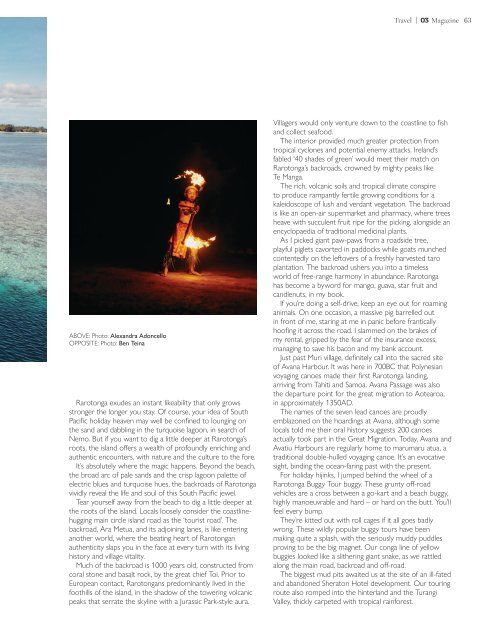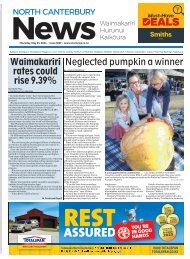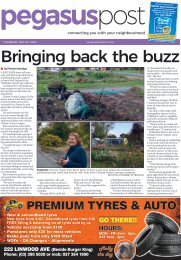03 Magazine: October 02, 2023
Create successful ePaper yourself
Turn your PDF publications into a flip-book with our unique Google optimized e-Paper software.
Travel | <strong>Magazine</strong> 63<br />
ABOVE: Photo: Alexandra Adoncello<br />
OPPOSITE: Photo: Ben Teina<br />
Rarotonga exudes an instant likeability that only grows<br />
stronger the longer you stay. Of course, your idea of South<br />
Pacific holiday heaven may well be confined to lounging on<br />
the sand and dabbling in the turquoise lagoon, in search of<br />
Nemo. But if you want to dig a little deeper at Rarotonga’s<br />
roots, the island offers a wealth of profoundly enriching and<br />
authentic encounters, with nature and the culture to the fore.<br />
It’s absolutely where the magic happens. Beyond the beach,<br />
the broad arc of pale sands and the crisp lagoon palette of<br />
electric blues and turquoise hues, the backroads of Rarotonga<br />
vividly reveal the life and soul of this South Pacific jewel.<br />
Tear yourself away from the beach to dig a little deeper at<br />
the roots of the island. Locals loosely consider the coastlinehugging<br />
main circle island road as the ‘tourist road’. The<br />
backroad, Ara Metua, and its adjoining lanes, is like entering<br />
another world, where the beating heart of Rarotongan<br />
authenticity slaps you in the face at every turn with its living<br />
history and village vitality.<br />
Much of the backroad is 1000 years old, constructed from<br />
coral stone and basalt rock, by the great chief Toi. Prior to<br />
European contact, Rarotongans predominantly lived in the<br />
foothills of the island, in the shadow of the towering volcanic<br />
peaks that serrate the skyline with a Jurassic Park-style aura.<br />
Villagers would only venture down to the coastline to fish<br />
and collect seafood.<br />
The interior provided much greater protection from<br />
tropical cyclones and potential enemy attacks. Ireland’s<br />
fabled ‘40 shades of green’ would meet their match on<br />
Rarotonga’s backroads, crowned by mighty peaks like<br />
Te Manga.<br />
The rich, volcanic soils and tropical climate conspire<br />
to produce rampantly fertile growing conditions for a<br />
kaleidoscope of lush and verdant vegetation. The backroad<br />
is like an open-air supermarket and pharmacy, where trees<br />
heave with succulent fruit ripe for the picking, alongside an<br />
encyclopaedia of traditional medicinal plants.<br />
As I picked giant paw-paws from a roadside tree,<br />
playful piglets cavorted in paddocks while goats munched<br />
contentedly on the leftovers of a freshly harvested taro<br />
plantation. The backroad ushers you into a timeless<br />
world of free-range harmony in abundance. Rarotonga<br />
has become a byword for mango, guava, star fruit and<br />
candlenuts, in my book.<br />
If you’re doing a self-drive, keep an eye out for roaming<br />
animals. On one occasion, a massive pig barrelled out<br />
in front of me, staring at me in panic before frantically<br />
hoofing it across the road. I slammed on the brakes of<br />
my rental, gripped by the fear of the insurance excess,<br />
managing to save his bacon and my bank account.<br />
Just past Muri village, definitely call into the sacred site<br />
of Avana Harbour. It was here in 700BC that Polynesian<br />
voyaging canoes made their first Rarotonga landing,<br />
arriving from Tahiti and Samoa. Avana Passage was also<br />
the departure point for the great migration to Aotearoa,<br />
in approximately 1350AD.<br />
The names of the seven lead canoes are proudly<br />
emblazoned on the hoardings at Avana, although some<br />
locals told me their oral history suggests 200 canoes<br />
actually took part in the Great Migration. Today, Avana and<br />
Avatiu Harbours are regularly home to marumaru atua, a<br />
traditional double-hulled voyaging canoe. It’s an evocative<br />
sight, binding the ocean-faring past with the present.<br />
For holiday hijinks, I jumped behind the wheel of a<br />
Rarotonga Buggy Tour buggy. These grunty off-road<br />
vehicles are a cross between a go-kart and a beach buggy,<br />
highly manoeuvrable and hard – or hard on the butt. You’ll<br />
feel every bump.<br />
They’re kitted out with roll cages if it all goes badly<br />
wrong. These wildly popular buggy tours have been<br />
making quite a splash, with the seriously muddy puddles<br />
proving to be the big magnet. Our conga line of yellow<br />
buggies looked like a slithering giant snake, as we rattled<br />
along the main road, backroad and off-road.<br />
The biggest mud pits awaited us at the site of an ill-fated<br />
and abandoned Sheraton Hotel development. Our touring<br />
route also romped into the hinterland and the Turangi<br />
Valley, thickly carpeted with tropical rainforest.


















